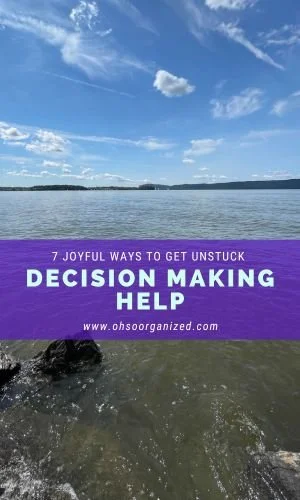One of the most common reasons my clients get stuck is being unsure about making decisions. A lack of confidence in decision-making might only affect specific areas. For example, they have no issue deciding which groceries to purchase or which social activities to attend. However, the decision-making challenge can surface when choosing how many black pants to let go of or where to begin organizing their home. It can feel like overwhelm, paralysis, or stress. This is an excellent time to reach out for help. There is no reason to remain in Stuckland.
There is another aspect to making decisions. Often, we’re on the fence about what to do. We have a few ideas but aren’t 100% sure which way to go. This is another terrific reason to enlist help. Use a decision-making buddy to help discuss options, weigh the pros and cons, or boost your confidence in making a choice.
7 Ways to Enlist Help Making Decisions
10 10 10 Rule
Before you make a decision, ask three questions:
10 minutes from now, how will I feel about this decision?
10 months from now, how will I feel about this decision?
10 years from now, how will I feel about this decision?
40/70 Rule
Former Secretary of State Colin Powell used this approach when making a quick decision. He would aim not to decide with less than 40% of the information needed, then act when he had close to 70% of the data.
80/20 Rule
Known as the Pareto Principle, this rule says that 80% of the outcomes (or outputs) result from 20% of all causes (or inputs) for any event. We often use this in the organizing world. For example, we only wear 20% of our clothes or refer to 20% of the papers we file. With that recognition, opting to let go will be easier.
3 Elements of Decision-Making
Clarify – Identify the decision to make or problem to solve.
Consider – Think about the options and the positive and negative consequences of each choice.
Choose – Choose the best choice.
“When all else fails, flip a coin.”
Golden Rules of Decision-Making
Make decisions when you’re . . .
not in pain and when your body feels strong
feeling loved and supported
feeling you are enough
Coin Flip
When all else fails, flip a coin. Heads you let ‘it’ go, tails you keep ‘it.” Then pay attention to how you react. Let your intuition guide you. Do the opposite of the coin toss result if the option doesn’t sit right in your gut.
Virtual Organizing
Decision-making is integral to all virtual organizing sessions with my clients. I provide support by:
Discussing the options
Holding space to think through a choice without feeling pressured
Setting boundaries around the decision
Reviewing pros and cons
Encouraging curiosity and experimentation
Empowering agency to make decisions
Focusing on progress, not perfection
These are just a few ways to boost your decision-making skills. What helps you get unstuck so you can make a decision? I’d love to hear your thoughts. I invite you to join the conversation.
Contact me, Linda, if you are stuck and need help and guidance to make decisions. Call at 914-271-5673, email linda@ohsoorganized.com, or click here. I’m here for you.













